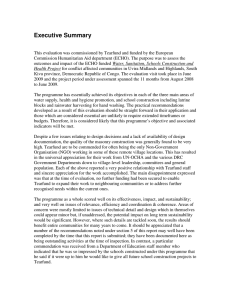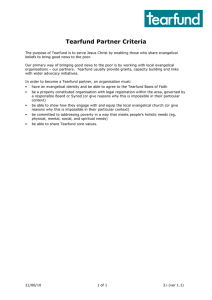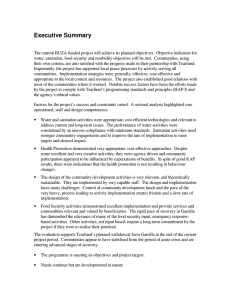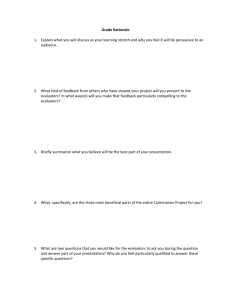EXECUTIVE SUMMARY
advertisement
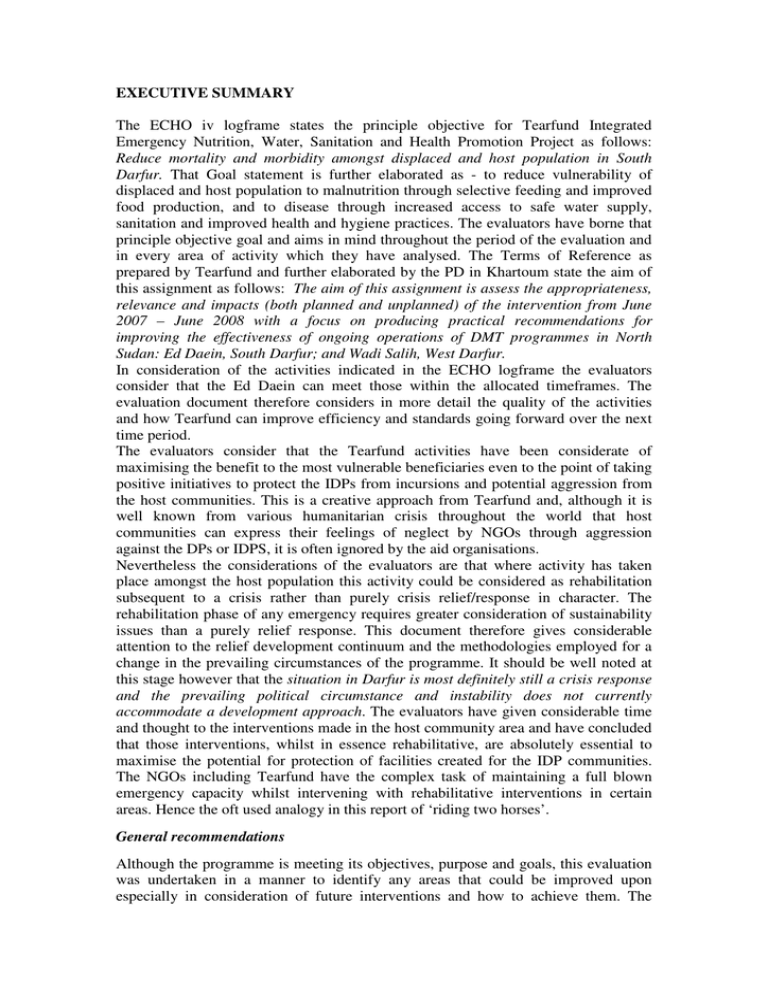
EXECUTIVE SUMMARY The ECHO iv logframe states the principle objective for Tearfund Integrated Emergency Nutrition, Water, Sanitation and Health Promotion Project as follows: Reduce mortality and morbidity amongst displaced and host population in South Darfur. That Goal statement is further elaborated as - to reduce vulnerability of displaced and host population to malnutrition through selective feeding and improved food production, and to disease through increased access to safe water supply, sanitation and improved health and hygiene practices. The evaluators have borne that principle objective goal and aims in mind throughout the period of the evaluation and in every area of activity which they have analysed. The Terms of Reference as prepared by Tearfund and further elaborated by the PD in Khartoum state the aim of this assignment as follows: The aim of this assignment is assess the appropriateness, relevance and impacts (both planned and unplanned) of the intervention from June 2007 – June 2008 with a focus on producing practical recommendations for improving the effectiveness of ongoing operations of DMT programmes in North Sudan: Ed Daein, South Darfur; and Wadi Salih, West Darfur. In consideration of the activities indicated in the ECHO logframe the evaluators consider that the Ed Daein can meet those within the allocated timeframes. The evaluation document therefore considers in more detail the quality of the activities and how Tearfund can improve efficiency and standards going forward over the next time period. The evaluators consider that the Tearfund activities have been considerate of maximising the benefit to the most vulnerable beneficiaries even to the point of taking positive initiatives to protect the IDPs from incursions and potential aggression from the host communities. This is a creative approach from Tearfund and, although it is well known from various humanitarian crisis throughout the world that host communities can express their feelings of neglect by NGOs through aggression against the DPs or IDPS, it is often ignored by the aid organisations. Nevertheless the considerations of the evaluators are that where activity has taken place amongst the host population this activity could be considered as rehabilitation subsequent to a crisis rather than purely crisis relief/response in character. The rehabilitation phase of any emergency requires greater consideration of sustainability issues than a purely relief response. This document therefore gives considerable attention to the relief development continuum and the methodologies employed for a change in the prevailing circumstances of the programme. It should be well noted at this stage however that the situation in Darfur is most definitely still a crisis response and the prevailing political circumstance and instability does not currently accommodate a development approach. The evaluators have given considerable time and thought to the interventions made in the host community area and have concluded that those interventions, whilst in essence rehabilitative, are absolutely essential to maximise the potential for protection of facilities created for the IDP communities. The NGOs including Tearfund have the complex task of maintaining a full blown emergency capacity whilst intervening with rehabilitative interventions in certain areas. Hence the oft used analogy in this report of ‘riding two horses’. General recommendations Although the programme is meeting its objectives, purpose and goals, this evaluation was undertaken in a manner to identify any areas that could be improved upon especially in consideration of future interventions and how to achieve them. The following were identified where the effectiveness, efficiency, impact and sustainability of the work could be improved. These recommendations are presented below in priority order and in summary form only: reference is made to the appropriate sections of the main text for the full discussion. Sustainability In order to maximise the sustainability of future interventions the programme must change implementation methodology from that of a purely relief ideology, methodology and quality to one which includes rehabilitation ideology which, being characteristically more akin to developmental than relief, makes consideration of sustainability through higher technical and engineering standards more significant. Please note that the report is stating ‘to include’. The nature of the chronic complex emergency precludes moving away from a crisis response and capacity since the situation in North Sudan could/can become a full blown emergency at any time and with at best short notice. The complexities of managing a chronic complex emergency is well covered in the detailed recommendations sections of the report. Although the intervention in North Sudan cannot, by virtue of the instability and volatility of prevailing circumstances in North Sudan, move away from crisis response to a development response it can, in order to enhance potential sustainability of interventions, begin to consider some aspects of the intervention as preliminary rehabilitation. The annex contains a detailed paper on the relief development continuum which, although not fully applicable to the North Sudan intervention, may provide some relevant input to the changing and complex nature of the programme. Those recommendations will identify clearly the need for improved technical and engineering standards, improved community participation components and in dramatic increase in teaching and training of personnel at various levels of the community. The evaluators have included a section in the report body on management structures. This section indicates some positive changes to programme management which Tearfund might consider to maximise efficiency and effectiveness. In particular the report looks at the change in the size of the programme and how the management model might be revised to address capacity deficiencies. On-going support The evaluation considers the real need for continued support to IDPs and retaining the capacity to respond to crisis which may happen at any time and without prior warning. Such relief crisis intervention is ongoing and may decrease or increase in the months and years ahead. The evaluation also considers the fact that increasingly there are rehabilitation activities being built into the programme and in regard to this shift in emphasis it is clearly documented that additional, or at least increased, educational and learning and training support is required by beneficiaries. This of course requires a ‘scaling up’ of Tearfund’s capacity both in professional standards of managers and in terms of areas of expertise. The report highlights (on more than one occasion in more than one sector) the need for ‘teachers and trainers’ and experts with the professional expertise to provide the materials to support those experts Future projects The consideration of prerequisites for future projects is well documented in the report under the recommendations sector. The reasoning for why these recommendations are documented is contained in the annex where the change to rehabilitation is highlighted and in the appendices on the relief development continuum.
